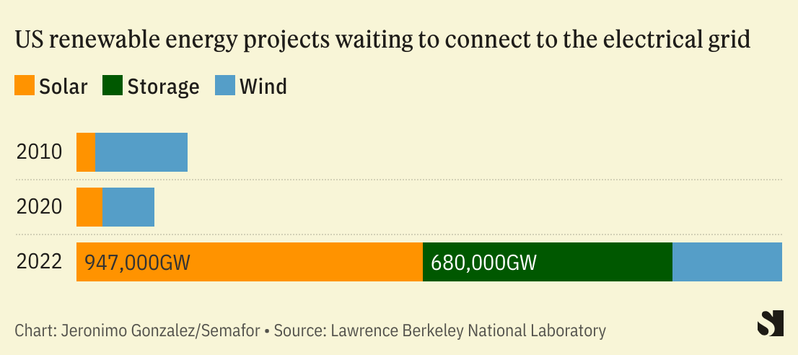The Facts
A year after the U.S. Inflation Reduction Act was signed into law, its global repercussions are coming into focus. Foreign leaders who decried its unapologetic protectionism as unfair have since crafted big-spending policy responses of their own. The U.S. has itself softened the harder edges of its groundbreaking program.
But while the IRA has undoubtedly lowered the U.S.’s emissions trajectory and bolstered domestic manufacturing, its effects on global decarbonization and on reducing American dependence on its adversaries are less uniformly positive.
Tim’s view
For the U.S. to catch up on the global clean-energy transition, it needed the IRA. And that meant challenging Western norms that frown on heavy-handed government interventions to prop up one country’s private markets.
In some ways, the IRA has actually drawn the global clean energy economy more tightly together and propelled it forward. But it also launched an expensive global subsidy war that many of the middle-income countries that benefited from globalization in prior decades can’t afford to compete in.
In fueling one of the world’s fastest-growing markets for electric vehicles, solar power, and other clean energy hardware, the IRA has proven to be a massive investment opportunity for non-U.S. companies. Out of around $110 billion in U.S. clean energy projects announced since it passed, at least 60% of that investment came from foreign firms, according to a Wall Street Journal analysis, mostly battery makers in Asia. The law has also spurred India, Japan, EU countries, Canada, and others to roll out their own versions of the IRA.

But certain IRA tax incentives are still limited to goods from a relatively small number of trading partners. In particular, this has left the U.S.’s critical mineral supply chain vulnerable, as the law leaves out many large producers of raw materials in South America, Southeast Asia, and Africa. That’s a problem not just because those materials are needed for the U.S. to meet its climate goals, but because Chinese firms are standing by to take more market share.
The IRA will make U.S. demand for lithium, cobalt, and nickel about 14% higher in 2035 than without the law, an S&P report this week concluded. The IRA is first and foremost a domestic industrial policy, but it has sharply illustrated how reliant the U.S. energy transition will continue to be on trade. And unless the U.S. moves more swiftly to shore up its global supply chain of critical minerals within the confines of the law, it risks taking a permanent backseat to China.
The View From THE EU
EU lawmakers’ initial concerns about the IRA centered largely on two issues: A likely fall in electric vehicle exports to the U.S., and the potential siphoning off of manufacturing investments to the U.S. that would otherwise have been made in Europe.
The U.S. Treasury smoothed the vehicle issue by dropping domestic content requirements for commercial and leased vehicles. Since the law was passed, EV exports to the U.S. from European and South Korean automakers have surged. And while EU rules make the rollout of broad subsidies more complicated, the bloc is loosening its restrictions. Individual companies have managed to successfully carry out subsidy bidding wars in direct response to the IRA, most recently steel makers Thyssenkrupp and ArcelorMittal, chip maker Intel, and battery maker Northvolt.
The View From Indonesia
Battery materials sourced from Indonesia, the world’s biggest nickel producer, don’t qualify for IRA tax credits. That has created a dilemma for President Joko Widodo’s government, said Andri Prasetiyo, a senior researcher at Senik Center Asia, a Jakarta-based climate policy think tank. The country is keen to build up its nickel processing industry, to get more value from the raw materials it mines and seize on a lucrative corner of the clean energy boom to offset its declining revenue from coal. Up to now, most of the investment in that industry has come from China, which has made U.S. officials wary of a new trade agreement proposed by Indonesia that would give it access to the IRA. So Indonesia is stuck between two powerful opposing investors — and the U.S., in the interest of isolating China, is also isolating itself from a badly-needed source of battery minerals.
Since the IRA creates an uneven playing field for mineral suppliers, the U.S. needs to be more proactive about forging mineral-focused trade deals that expand its base of qualifying suppliers, said Melissa Barbanell, director of U.S.-international engagement at the World Resources Institute. But any new trade deals need to come with the same high labor and environmental standards it applies to IRA-backed projects in the U.S., she said, which a mineral agreement signed with Japan in March failed to do.
The View From China
China’s clean energy industry is already so much bigger than the U.S.’s that a subsidy war isn’t much of a threat to Beijing. Instead, China’s response to the IRA has been to accelerate its investment in global mineral production, processing, and trading, racing ahead to control the roots of the supply chain. Efforts to completely excise China from the U.S. clean energy industry will ultimately raise costs and cut U.S. manufacturers off from technology, know-how, and materials they need to scale.
“We need to admit that no country will easily shift China’s dominance in the near term, if ever,” said Li Shuo, global policy adviser for Greenpeace East Asia. “The bottom line is the U.S. and China will be two severed markets in some regards while still deeply connected in others.”
Room for Disagreement
Because of its support for domestic consumption of renewable energy and EVs, the IRA has had a demonstrable impact on lowering U.S. carbon emissions. Whether it will accelerate global decarbonization is a different question. U.S. officials frequently claim that R&D breakthroughs and economies of scale achieved by the IRA will ultimately lower costs for all global consumers of clean tech. But the recentering of manufacturing in a high-cost environment like the U.S., and protectionist measures other countries take in response, may raise costs in the near term.
Notable
- One area where the IRA is giving the U.S. a particular edge over Europe is in low-carbon hydrogen. Since the law passed, venture capital investment in U.S. clean hydrogen projects — which are supported by one of the IRA’s largest single tax benefits — has exceeded Europe’s total by $1.3 billion, the largest margin of any cleantech sector, the Financial Times reported.


